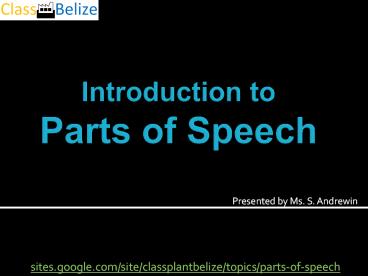Parts of Speech Part 1 PowerPoint PPT Presentation
Title: Parts of Speech Part 1
1
Introduction to Parts of Speech
- Presented by Ms. S. Andrewin
sites.google.com/site/classplantbelize/topics/part
s-of-speech
2
8 Parts of Speech
3
Nouns
- A noun is a word that names a person, a place, a
thing, or an idea.
Persons soldier, Ms. Eck, sibling
Places British Virgin Islands, school, platform
Things football, map, video game
Ideas democracy, brotherhood, indifference
NB Dates and days of the week are also
classified as nouns
4
Noun Classifications
- Presented by Ms. S. Andrewin
5
Noun Classifications
6
Classification of Nouns
- Common Nouns
- Proper Nouns
- Common nouns are general names
- A common noun should not be capitalized unless it
begins a sentence. - school, sea, teacher
- Proper nouns name specific things.
- Proper nouns always begin with a capital letter.
- Palotti, Caribbean, Ms. Andrewin
7
Classification of Nouns
- Compound Nouns
- Collective Nouns
- Compound nouns are words used together to form a
single noun. - Swimming pool
- Hannah Montanah
- High school
- A collective noun refers to a group of people,
places, things, or ideas. - Flock
- Army
- gang
NB Different from plural nouns.
8
Classification of Nouns
- Concrete Nouns
- Abstract Nouns
- Concrete nouns refer to material things, people,
or places. - Tend to refer to things that can be perceived by
the senses - Books, person, turnip
- Abstract nouns name ideas, qualities, emotions,
or attitudes. - Any noun that cannot be perceived by any of the 5
senses is an abstract noun. - Optimism, Nostalgia, Self-Importance
9
Pronouns
- Presented by Ms. S Andrewin
A pronoun is a word used in place of a noun. A
pronoun identifies persons, places, things, or
ideas without renaming them.
10
Pronouns
- Presented by Ms. S Andrewin
The noun that the pronoun replaces is the
antecedent of the pronoun.
11
Pronouns Types
- There are 7 Types of Pronouns
12
Pronouns Types
- There are 7 Types of Pronouns
13
Pronouns Types
- There are 7 Types of Pronouns
14
7 Types of Pronouns
- Personal
- Possessive
- Personal pronouns that show ownership or
belonging are called possessive. - Is this pen yours or mine?
- Require different forms to express person,
number, and gender. - Person refers to the relationship between the
communicator and the person being addressed. - Number indicates whether the antecedent is
singular or plural.
15
7 Types of Pronouns
- Demonstrative
- Reflexive
- Specify the individual or group that is being
referred to. - This is Janes sculpture, and that is Erics
painting. - Of the six meals of the menu, those are more
delicious than these.
- Indicate that people or things perform actions
to, for, or on behalf of themselves. - We gave ourselves four days to make the drive.
- Mr. Anderson is building himself a new garage.
16
7 Types of Pronouns
- Intensive
- Interrogative
- Same words as reflexive pronouns
- Used to draw special attention to persons,
places, or objects - Have you talked to the teachers themselves?
- Introduce questions
- Who is in the back yard?
- What is the answer to the problem?
- Which did you choose?
17
7 Types of Pronouns
- Relative
- Indefinite
- Introduce adjective clauses
- Have you read The Tell-Tale Heart, which was
written by Edgar Allan Poe? - I will be working with Mr. Tabony, for whom I
have utmost respect.
- Refer to people, places, in things in general.
- Often used without an antecedent.
- Although most of the items were for sale, few
were sold.
18
Verbs
- Presented by Ms. S. Andrewin
A verb is a word that expresses an action or a
state of being.
19
3 Only
20
Action Verbs
- An action verb describes the behaviour or action
of someone or something.
- Cal broke the plate.
- We saw the large satellite.
- I remember our trip to Brazil.
- Chris dreamed of sailing around the world.
Action verbs may represent physical or mental
activities.
21
Action Verbs
- Transitive
- Intransitive
- A verb is transitive when its action is directed
toward someone or something, which is called the
object. - The hurricane winds bent the citys trees toward
the earth.
- A verb is intransitive when its action is not
directed toward someone or something. - Intransitive verbs do not have objects.
- Sir Baron Bliss lived in Belize for the latter
part of his life.
All action verbs are either transitive or
intransitive.
22
Linking Verbs
- A linking verb connects a noun or pronoun with
words that identify or describe them.
- This is a painting by Vincent Van Gogh.
- The architects who designed the new mall were
certainly inventive. - Charlie sounded sleepy on the phone.
- Jodie will become a pharmacist some day.
Many (but not all) linking verbs are verbs of
being, which are forms of the word be.
23
Auxiliary Verbs
- An auxiliary verb is used to help an action or a
linking verb. The verb it helps is called the
main verb.
- Have the Robinsons bought a new car?
- Fred and Leila were always competing.
- Can the city council pass this bill on time?
- By the end of the semester, we will have written
several essays.
Together, a main verb and an auxiliary verb form
a verb phrase.
24
sites.google.com/site/classplantbelize/topics/part
s-of-speech

